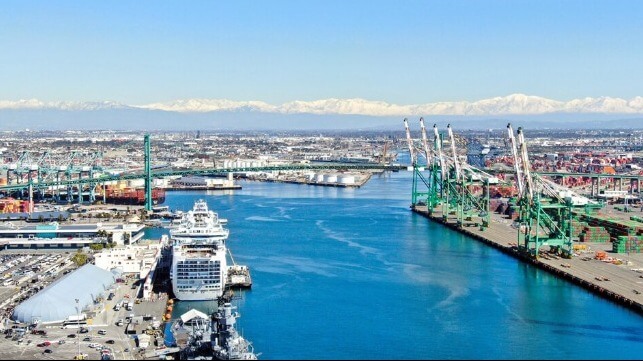Southern California Ports See Steep Monthly Volume Declines

Executives at the ports of Long Beach and Los Angeles this week again confirmed that trade has slowed dramatically highlighting steep declines in container volumes and holding out little hope for an immediate recovery. Each of the ports reported sharply lower volumes versus the records reported a year ago.
Some of the declines in February are typical as it is a shorter month and frequently strongly impacted by the timing of the Asian Lunar New Year holidays, but much of it comes from the broader slowing in demand. Port of Los Angeles Executive Director Gene Seroka in today’s monthly briefing highlighted that the slowdown is a global phenomenon while saying, “Demand is just not there now.”
Seroka highlighted several factors saying that economic uncertainty is playing a big part while consumers continue to feel the impact of inflation. The primary issue though that he points to and say has to change before things get better is the high inventory levels in U.S. warehouses. He said “old inventories are just not moving fast enough,” noting that retailers especially need to clear levels before the next wave of imports can begin.
As a result, the Port of Los Angeles reported a 43 percent decline in volumes for February to its lowest volumes since March 2020. The port handled just under 489,000 TEU, which was also off by a third compared to the port’s five-year average. The declines came in across the board in imports (off 41 percent), exports (14 percent decline), and handling empty boxes (less than half).
Equally telling was the number of vessels arriving at the port. The month saw 61 containerships versus 93 a year ago. Carriers blanked 30 sailings from the port’s schedule, reminiscent of levels seen when the pandemic began three years ago. Seroka points out that there are more boxships idled now than at any time in the past few years.
The dragging on of the labor negotiations for West Coast longshore workers he also believes continues to impact volumes. Shippers have directed volumes away from the ports and according to Seroka need to see the contract agreement to be assured of avoiding possible disruptions in their shipments. He believes both sides continue to work in good faith on the agreements but points out the turnover in U.S. Labor Secretary coming this month. Seroka is calling for a “spring agreement,” to help the outlook.
The neighboring Port of Long Beach reported slightly better performance handling 543,675 TEU down just about a third from last year’s levels. Imports were down 35 percent in Long Beach while exports were off nearly 6 percent in February.
“Trade continues to normalize following the record-breaking cargo numbers we saw at the start of last year,” said Port of Long Beach Executive Director Mario Cordero. “We are investing in infrastructure projects that will keep us competitive as we collaborate with industry stakeholders to focus on trade volume.”
Seroka predicts that the next few months will see “lighter volumes” particularly versus last year’s record levels. However, he notes that vessel traffic is moving closer to normal a point confirmed by the Marine Exchange of Southern California which says there are now 7 to 18 container vessels on berth each day compared to 10 to 20 a day before the pandemic. Seroka notes that many of the idled vessels are positioned near China meaning they are ready to quickly resume sailing when there is demand.
Because many shippers have also been holding back on long-term contracts with the carriers waiting to see if rates will fall lower, the Southern California ports see any opportunity once the labor settlement is reached. Shippers will be able to switch back to normal patterns as they are not locked into rate contracts.
Seroka concludes his presentation by pointing to economists and analysts that expect a rebound in trade in the second half of 2023. He predicted March volumes would be up 20 percent from February’s lows and that mid-year would see a sustained pickup in volume. The National Retail Federation in its forecast echoed a similar outlook saying they expected volumes to start to build back in March with more positive outlooks for the second half of the year.
No comments:
Post a Comment